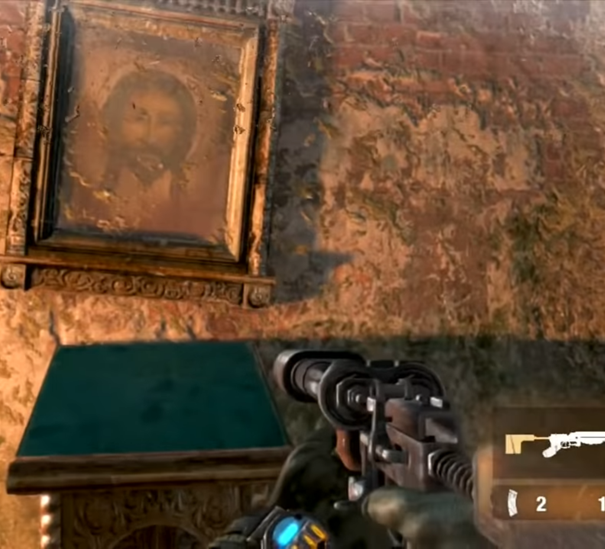The midst of a post-apocalyptic video game is perhaps not the most self-evident place to find a Christ icon. Nevertheless, that is precisely what Metro Last Light (2013) is doing (see image #1). The Metro series take place in Moscow in 2023, after the world suffered severely in ‘The Last War’, a nuclear war that annihilated humanity almost completely and disrupted all flora and fauna. In the metro stations under Moscow, approximately 50,000 people survived, the sole remnant of humankind. And, of course, where there is people, there is conflict. The metro is no exception to that cynical rule: neo-Nazis and Neo-Communists are fighting over power, food, and water.

Figure 1: The Icon of Christ in Metro Last Night
In one instance, Artyomn, the player’s avatar, has to travel to the completely irradiated and mutants-crawling surface to find his arch enemy, Pavel. And then, the icon appears. The question is: what is it doing there? What does it mean?
Genesis trailer: theodicy
To answer this question about the meaning of the icon in Last Light, we must take a step back and look at one of the game’s original trailers, called “The Genesis Trailer” (https://youtu.be/W4pD5cISn_U; see below). In this trailer, an English-speaking voice-over paraphrases the Genesis 1 text on the seven days God created heaven and earth. While we hear about God’s original creation – which is described repeatedly by Genesis as “good” – we are shown what humankind has done with this “gift”: the utter destruction of the world and everlasting conflict among people. Humankind is created, the voice-over stresses, after “God’s image”, what is called in theological terms the imago Dei.
The Genesis Trailer of Metro Last Night
“On the seventh day,” the narrator continues, “they say God rested.” Doubt is entering the voice-over’s narrative: it has become hear-say. It is only a prelude to voice-over’s continuation: “But God didn’t rest. God went away or perhaps died. Judgement Day came and He abandoned us, casting humanity aside like parasites.” Here, the trailer evokes the theological conundrum of the theodicy. This problem is inherent to all monotheistic religions. As Hume summarized in part 10 of his 1779 Dialogues concerning Natural Religion:
[I]s [God] willing to prevent evil, but not able? Then is he impotent. Is he able, but not willing? Then is he malevolent. Is he both able and willing? Whence then is evil?
Metro's struggle with the theodicy problem is not coincidentally framed in an apocalyptic context of a post-nuclear world in our near future. Neither is the extensive use of ecological and biological anomalies in the 'Genesis trailer'. Metro clearly builds on our contemporary ecological (climate crisis) and political predicaments (the war in Ukraine and the rising tensions between the nuclear world powers), extrapolating these into a fictional future.
In the Metro universe, the conclusion seems to be: there is no God. If God would have existed, He would have prevented the nuclear disaster. The nuclear disaster did occur, so God cannot exist. Metro does not provide a theodicy, but an anti-theodicy, the denial of God’s existence. This means that the world of Metro is an atheist one: not as an ideology, but as a matter-of-fact. The only hope, the narrator continues, lies in “my own hand”, the hands of the game’s hero, who appears to be the narrator of the trailer. And because in games, the player’s avatar is entanglement with the player itself, hope lies exclusively in the hands of the players.
Choice: be a Christ
This hope is reiterated in the scene with the icon. In a devasted and ruined version of the Mother of God Cathedrale in Moscow, Artyom-cum-the player find his worst enemy, Pavel, incapacitated against a cupboard in one of the cathedral’s corridors. He wears a gas mask – which you need to survive on the contaminated surface – but no filter is attached. Artyom/the player is given the choice to do nothing and let Pavel die, or to screw a filter on his mask and save his life. In both instances, the Christ icon, hanging above Pavel’s cupboard, is looking directly at Artyom/the player. It is one of the most striking aesthetical features of many icons: they stare you directly in the eyes judging the viewer silently.
If Artyom/the player has decided to save Pavel, the icon judges your actions favorably: you have done well from a moral-religious point of view. If Artyom/the player decides to do nothing and let Pavel die, the icon judges your actions dismissively: you did bad from a moral-religious point of view. The game features an implicit morality system: a system that judges certain player’s actions against a pre-supposed ethical framework. This Pavel-choice is one of the instances the game rates the player: according to all player choices combined, the game’s ending is changing.
Now, back to the God-forsaken world of Metro, as the Genesis Trailer portrayed it. The trailer defined being human – quite classically – as the imago Dei, humans are created after God’s likeness. And within Christian tradition, Jesus Christ is considered to be the perfect example of this: Christ is the imago Dei par excellence. So, if Artyom/the player decides to forgive his worst enemy, the player is answering to God’s original idea as it was incarnated in the life of Jesus Christ. And visa versa of course. So, in the atheist world of Metro, it is the player can choose to become a “christophoric” figure, a figure answering to the imago Dei, mirroring the Christ, representing God in an otherwise godless world.
See also for more photos and my PowerPoint presentation: https://frankgbosman.wordpress.com/2023/07/13/the-icon-of-cold-war/.
See also my contribution on the Metro series in CenSAMM’s Critical Dictionary of Apocalyptic and Millenarian Movements (CDAMM): https://www.cdamm.org/articles/metro.


The Icon of the Cold War